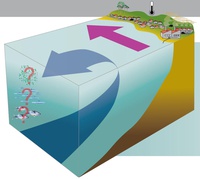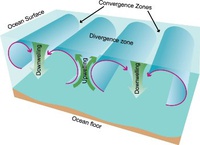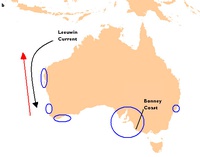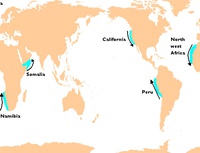Upwelling and Downwelling in the ocean
What is upwelling and downwelling and what does this mean for the earth's oceans?
-
Upwelling in the current climate off a southern hemisphere coast. Wind is parallel to the coast, and water is deflected to the left of the wind by the Coriolis force. Surface water is pushed offshore and is replaced by cool, nutrient-rich water from depth
-
The relationship between downwelling, convergence zones and upwelling (Image: AE Nieblas, CSIRO)
-
Australia does not have a large-scale upwelling area because it is suppressed by the poleward-flowing Leeuwin Current. Regional-scale upwelling occurs in NW WA, in SW WA, near the separation point of the East Australia Current from the east coast at Sugar Loaf Point, and in SE Australia, including the Bonney Coast (image: CSIRO).
-
Globally, most upwelling regions are found along the west coasts of continents. Large-scale upwelling off the west coast of Australia is suppressed due to the poleward-flowing Leeuwin Current.
Upwelling and downwelling describe mass movements of the ocean, which affect both surface and deep currents. These movements are essential in stirring the ocean, delivering oxygen to depth, distributing heat, and bringing nutrients to the surface.
Upwelling is the movement of cold, deep, often nutrient-rich water to the surface mixed layer; and downwelling is the movement of surface water to deeper depths.
Downwelling occurs when surface waters converge (come together), pushing the surface water downwards. Regions of downwelling have low productivity because of the nutrients get used up and are not continuously resupplied by the cold, nutrient-rich water from below the surface.
Upwelling occurs when surface waters diverge (move apart), enabling upward movement of water. Upwelling brings water to the surface that is enriched with nutrients important for primary productivity (algal growth) that in turn supports richly productive marine ecosystems. Upwelling regions are often measured by their productivity due to the influx of nutrients to the surface mixed layer and euphotic zone (sunlit layer) by upwelling currents. This drives photosynthesis of phytoplankton (tiny alga), which form the base of the ocean food web. Upwelling regions are less than 1 per cent of the world’s ocean by area, but account for greater than 20 percent of the global fish catch.
Some of the most important upwelling regions are along the coasts of continents. In these coastal upwelling regions, surface winds push water away from the shore and create a divergence at the coast, which is replaced by water from depth. For coastal upwelling to occur, the wind must be parallel to the coast because water is deflected to the left of the wind in the southern hemisphere, and the right of the wind in the northern hemisphere. This deflection is due to the Coriolis force which causes objects travelling in a straight line appear to curve or deflect due to the rotation of the earth.
(Edited by Yvette Barry)
Links and further information:
Want to know more about the Coriolis force?
Check out the National Oceanic and Atmospheric Administration Website.
Sources
Nieblas AE, Sloyan BM, Hobday AJ, Coleman R, Richardson AJ (2009) Variability of biological production in low wind-forced regional upwelling systems: a case study off southeastern Australia Limnology and Oceanography 54:1548-1558
Pauly D, Christensen V (1995) Primary production required to sustain global fisheries. Nature 374:255 - 257
Nieblas AE, Sloyan BM, Coleman R, Richardson AJ (2009) Variability of biological production in low wind-forced regional upwelling systems: a case study off southeastern Australia Limnology and Oceanography 54:1548-1558
Thurman H, Trujillo A (1999) Essentials of Oceanography. Macmillan Publishing Company, New Jersey, USA. pp 527.















